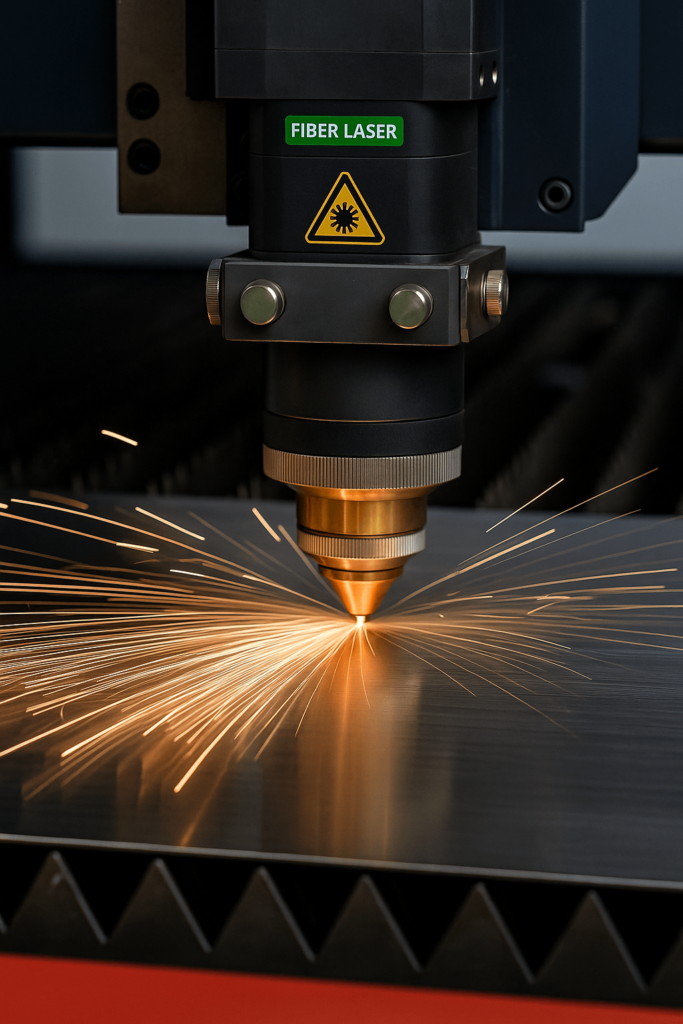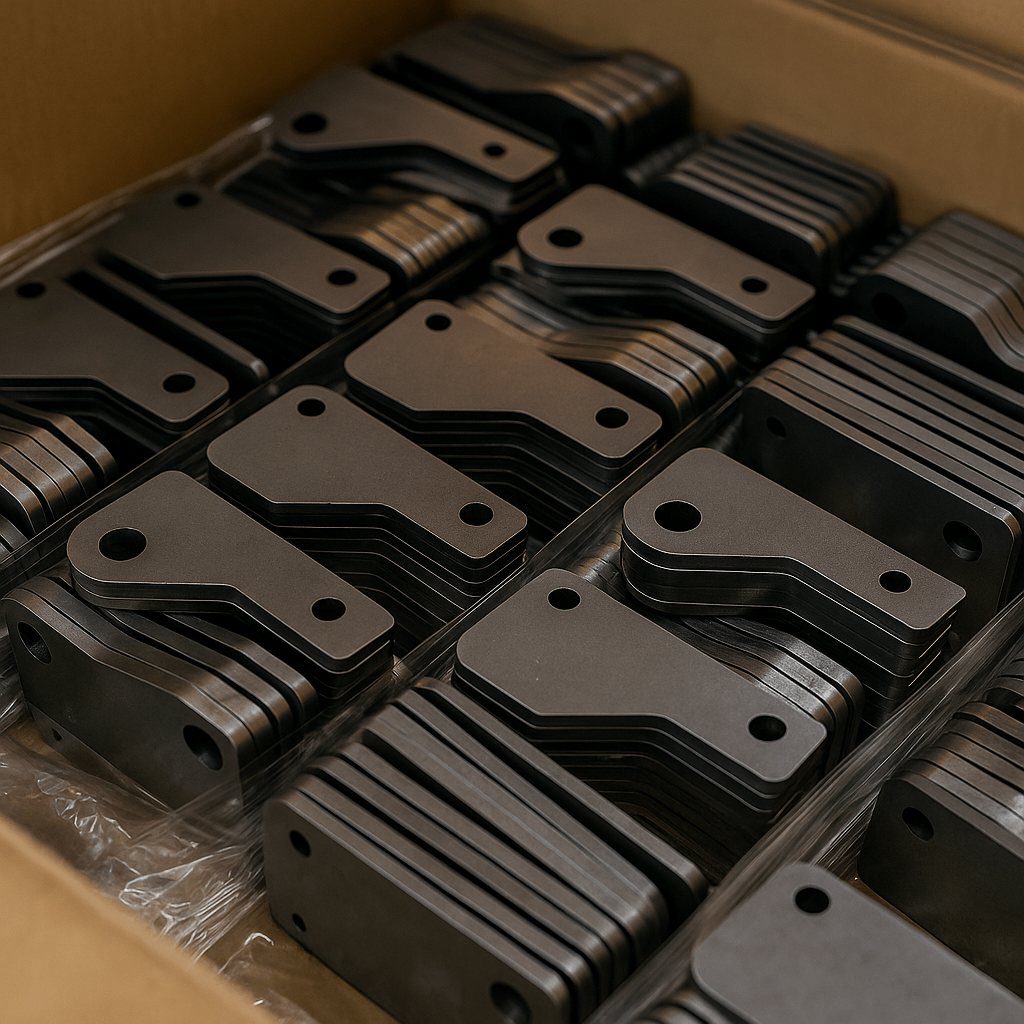Context Matters: Procurement Decisions Go Beyond Specs
For global wholesale buyers sourcing laser cutting equipment—especially those seeking bulk laser cutting services for metal parts—the choice between fiber and CO₂ systems is less about specs on paper and more about consistent throughput, maintenance predictability, and ROI across distributed production lines.
Whether you’re supplying telecom enclosures, building aluminum frames, or creating laser cut metal signs, the laser source directly influences your production economics.
At YISHANG, we understand that choosing the right technology isn’t just a technical decision—it’s a sourcing strategy. This guide shares insights based on wholesale application scenarios and customer purchase behaviors worldwide, offering clarity beyond the “fiber laser vs CO₂” debate.
Understanding the Technology: What Really Powers the Cut
Fiber Lasers: Built for Precision Metal Cutting
Operating at a wavelength of ~1.06 μm, fiber lasers excel in metal absorption. This makes them ideal for high-volume applications like stainless steel laser cutting, laser cut aluminum, and copper bracket production.
Their beam quality supports accurate laser cutting, even in complex parts such as precision tube laser applications and custom laser cut metal signs.
Fiber systems convert over 30% of input energy efficiently, helping cut both operational cost and carbon footprint—key for sustainability-focused buyers.

CO₂ Lasers: Best Fit for Non-Metals and Aesthetic Jobs
CO₂ lasers, emitting at ~10.6 μm, perform exceptionally on organic materials. For buyers in the signage or packaging sector, this means clean, flame-polished edges on acrylic or laser cut MDF displays.
Applications like laser cut stencils, laser cut artwork, or personalized laser cut metal signs remain strongholds for CO₂ systems.
However, the laser tube in CO₂ systems often requires periodic replacement, and their mirror alignment demands routine maintenance. These factors increase downtime risk, particularly for wholesale orders with fixed delivery cycles.
Industry Standards: Ensuring Compliance for Metal Cutting
For procurement teams evaluating industrial laser cutting solutions, compliance with international standards is often critical. Fiber laser systems, for example, consistently meet specifications like ASTM A240 for stainless steel, DIN EN 10088 for sheet metals, or ISO 9013 for thermal cutting quality. This makes them ideal for industries with strict tolerances—such as telecom enclosures or aerospace brackets.
By contrast, CO₂ systems may fall short in edge angularity or heat-affected zones, which can disqualify parts for certain OEM supply chains. Understanding how your laser system aligns with certification norms helps mitigate sourcing risk.
System Integration & Automation Readiness
Beyond cutting performance, modern fiber lasers integrate smoothly with industrial software ecosystems such as MES (Manufacturing Execution Systems), ERP, and remote quality monitoring systems. This plug-and-play capability is essential for buyers planning factory automation upgrades or multi-site equipment standardization.
One YISHANG client—an Eastern European OEM supplier—deployed a fiber laser machine for stainless steel bracket production and achieved synchronized job dispatching across three production lines using Siemens MES integration. CO₂ systems, while useful for creative tasks, often lack this native compatibility.
Performance in Practice: Speed, Precision, and Consistency
Cutting Speed vs. Thickness: Time Is Margin
Fiber lasers deliver faster speeds on thin to mid-thickness metals. A 3kW system can cut 3mm aluminum over 25 m/min, allowing fast order turnover.
For wholesale orders of hundreds of laser cut boxes or frames, time savings add up.
On thick mild steel (20mm+), CO₂ may yield smoother edges, but the process is slower. In bulk operations, slow speeds translate to bottlenecks, affecting your fulfillment rate.
Edge Quality & Secondary Processing
In summary for buyers managing multiple SKU configurations—especially those producing both structural parts and branded signage—the edge finish directly impacts your finishing costs and packaging workflows.
Fiber systems are often the best fiber laser for stainless steel signage when burr-free edges and minimal heat marks are essential.
Buyers sourcing laser cutting machine metal setups often underestimate downstream costs. Fiber lasers leave cleaner edges with smaller HAZ (heat-affected zones), minimizing rework.
Whether you’re making laser cut steel signs or laser cut metal panels, this edge quality reduces sanding, grinding, or polishing.
CO₂ systems may outperform on thick plastics or acrylics, producing superior finishes without flame marks—a critical factor for high-end laser cut signage or decor.
Material Compatibility: Metal vs Mixed-Material Workflows
For procurement teams sourcing a laser cutting machine for copper parts, it’s essential to consider reflectivity and beam interaction. Fiber lasers handle cutting copper on laser setups or aluminium laser cutting service workflows safely and efficiently.
Reflective metals like brass or aluminum pose a back-reflection risk in CO₂ systems. Fiber lasers are more compatible and safer for those materials.
If your product line includes MDF, textiles, or layered signage, CO₂ remains relevant. But for dedicated metal work, fiber is the reliable workhorse.

Operating Costs, Energy, and Workflow Efficiency
Energy Efficiency and Consumption
Fiber systems often use 30–50% less energy than CO₂ counterparts. In international facilities or energy-regulated zones like the EU, this directly affects compliance and long-term costs.
For instance, a 6kW fiber laser running two shifts can save thousands annually compared to a similarly rated CO₂ system. If you operate high-output stations for laser cutting machine aluminum production, this is not a minor difference.
Maintenance Planning: Downtime Impacts Delivery
CO₂ systems involve frequent maintenance—from mirror realignment to gas tube replacements. Fiber systems are sealed, requiring far fewer interventions.
This matters for buyers managing weekly dispatch cycles or sourcing from multiple regional hubs.
Floor Layout and Cooling
CO₂ lasers often require large chillers and more space. Fiber systems, especially below 6kW, can be air-cooled or fitted with compact chillers.
This is crucial when buyers must fit new systems into legacy floorplans or shared production zones.
Cost Structure: Investment, Payback, and Risk for Procurement Teams
CapEx vs OpEx: Lifecycle Cost View
A fiber system might cost 20–40% more upfront, but the ROI window is shorter. Buyers with fiber setups for stainless steel laser cutting often recover their investment within 12–18 months—half the time of many CO₂ installations.
For example, one buyer comparing fiber laser price vs CO₂ for factories found that the fiber option delivered nearly double the output volume with 30% less energy input.
For buyers producing custom laser cut signs at volume, fiber systems accelerate ROI and boost labor efficiency—driving stronger pricing power.
Predictable Budgeting & Part Cost Accuracy
Fiber maintenance involves lens checks and occasional cleaning. CO₂? You need contingency for gas outages, optics replacement, and chiller failures.
Wholesale buyers building annual budgets need predictability. Fiber systems give you that—especially across tube laser cutting stations or automated production cells.
Which System Fits Which Buyer?
YISHANG has extensive experience delivering fiber systems to OEM manufacturers across North America and Europe.
These case studies reinforce how fiber laser cutting for OEM manufacturers leads to scalable improvements in both output and precision.
Fiber: For Metal Product Buyers Focused on Volume
If your orders include laser cut metal signs, enclosures, or tube laser cut components, fiber is a natural fit. It supports precision laser cutting, high throughput, and simplified automation—even across multi-plant networks.
From furniture frames to telecom housings, YISHANG clients often integrate fiber systems into their aluminum laser cutting service lines or precision tube laser pipelines.
For CNC fiber laser for small batch cutting, fiber platforms offer the agility and turnaround speed to accommodate fluctuating demand.
CO₂: For Buyers in Signage, Decor, or Mixed-Material
If your business revolves around laser cut signs metal designs, engraved woodwork, or layered acrylic branding, CO₂ still delivers best-in-class surface finishes.
For example, CO₂ remains the preferred tool for best selling laser cut products like promotional signage or decorative panels.
Hybrid Models: For Mixed SKUs
Some wholesale clients opt for hybrid setups—using fiber for structural parts and CO₂ for embellishments. It’s a strategic choice when buyers need flexibility for both visual and load-bearing parts.
Need the best laser cutter for aluminum enclosures and still offer engraved signage? A hybrid model can help you deliver both—efficiently.
Future-Proofing the Procurement Strategy for Factory Automation
Fiber systems are ideal in the fiber vs CO₂ laser for factory automation conversation, especially as industrial facilities shift toward lights-out manufacturing models.
Fiber lasers are evolving fast. 12kW+ systems now handle plate steel and laser pipe cutting with minimal prep. For buyers evaluating next-generation CNC laser cutting machines, fiber systems dominate the roadmap.
Fiber is also integrating faster with smart factory protocols—MES, ERP, and cloud-based QA tools. For facilities pushing automation, from tube laser services to custom laser cut designs, this offers massive leverage.
CO₂ is not obsolete. It will remain important in creative industries and acrylic-based packaging. But its footprint in heavy-duty production will shrink.
Closing Thoughts: Align Tech With Your Supply Model
Choosing between fiber and CO₂ isn’t about trend-chasing. It’s about volume, edge quality, maintenance cycles, and SKU diversity.
| Category | Fiber Laser | CO₂ Laser |
|---|---|---|
| Ideal For | Metal parts, reflective surfaces | Non-metals, signage, decor |
| Speed | High on thin metals | Moderate, better on thick acrylics |
| Maintenance | Low | High (optics + tubes) |
| Materials Supported | SS, Al, Cu, brass | MDF, acrylic, fabric |
| Automation | Fully compatible | Limited |
| ROI Window | 12–18 months | 24–36 months |
Buyer Tip: Avoid These Common Pitfalls
Expecting CO₂ to handle copper or brass efficiently
Assuming fiber works well on MDF or wood
Failing to calculate energy costs across multiple shifts
Not verifying local service availability before choosing laser tube brands
FAQ: What Wholesale Buyers Ask Most
Q: Which is better for high-speed aluminium laser cutting?
Fiber lasers. They offer precision laser cutting and lower burr risk.
Q: Can a fiber system cut wood or MDF?
No—for laser cut MDF or signage, CO₂ is still superior.
Q: How can I ensure accurate laser cutting across shifts?
Fiber systems with CNC nesting and feedback sensors offer better consistency.
Q: Are tube laser services better with fiber or CO₂?
For metal tubing—fiber. For PVC or hybrid shapes—CO₂ may apply.
Q: What’s the best laser cutting machine for industrial-grade aluminum signs?
Fiber laser machines offer unmatched precision, speed, and edge quality for bulk aluminum signage production.
Q: What brands does YISHANG support for laser integration?
We support global OEMs and help integrate both fiber and CO₂ systems based on your production model.
Ready to explore your next cutting solution? Talk to YISHANG for expert guidance or a tailored quotation.

